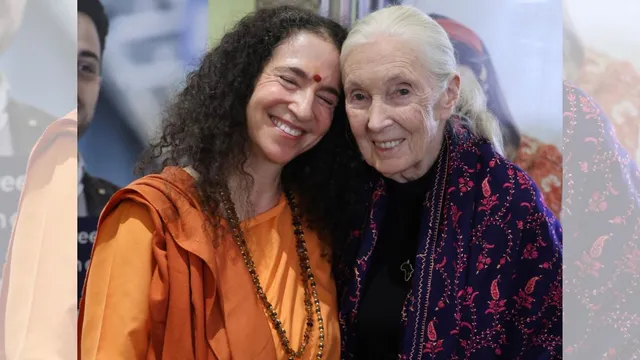- By Chidanand Saraswati
- Fri, 03 Oct 2025 05:12 PM (IST)
- Source:JND
“I don’t need to sit. I can dance.” Jane Goodall announced to me, and she demonstrated by twirling around the front of the room. I had asked her assistant to get a chair for her so she could do her 9:30 pm question/answer session sitting down rather than standing up. She was ninety years old at the time and in Mumbai on a four-day tour last November. I had been with her since 9 am that morning when she arrived for her first event of the day during her trip to Mumbai.
She gave a 45-minute unscripted keynote speech (standing!) and then graciously proceeded to be part of innumerable individual and group photos with the audience. In a continual flow, she then gave another program in the afternoon, during which she again gave a 45-minute keynote – also standing -- and returned to the hotel in the evening for the gala gathering by the British Council and Jane Goodall Institute of India.
She lovingly offered to do a post-dinner, intimate Q and A. And no, she still did not need to sit down, as she made abundantly clear by her loving indignation when I suggested a chair.
This was Jane, my hero since at ten or eleven I started plastering the walls of my bedroom with pages torn from National Geographic of photos of Jane with chimpanzees. Whenever anyone asked me, “What do you want to be when you grow up?” my answer was clear: Jane Goodall.
Even though divine destiny brought me to Rishikesh, India, rather than Gombe, Tanzania, Jane has remained my lifelong hero. It is not only her passionate and fervent work for the environment, but it is the deep love with which she does it. There are a lot of environmental activists.
There are a lot of animal rights activists. There are a lot of people working with children. And there is a lot of anger, a lot of frustration and a lot of hopelessness. Jane’s work flowed from love, not rage. She travelled around the world, three hundred days a year, fueled by love.
When I was in England this summer for some events, I reached out to see her. She was in Gombe with her family – a family of chimpanzees (and of course a few humans!). Ninety-one and spending her brief summer holiday with the chimps in Tanzania rather than in her home in England.
During the question-answer session, she opened by dancing, and someone asked her, “What is your anti-ageing secret for longevity?” After all, it was nearly 10 pm, she had arrived in India from London only the day before, we had been with her until late the previous evening, and throughout the day. And, of course, she was 90 and yet seemed she could have gone on all night! So what was her anti-ageing longevity secret? Not a tonic or a vitamin or a! ily ritual or specific exercise or a strict diet (other than being vegan, she ate everything quite happily!).
She responded, “I just love animals, and I love children, and I love the planet. People have told me that my voice inspires them to take care of animals, children, and the planet, so I keep travelling to bring inspiration.” That was her secret to being 91 years young: Love. And work fueled by love.
Through love, she transformed the way scientists understand the similarities between humans and animals. She sat with families of wild chimps in the forest of Tanganyika (now Tanzania), the way an opera lover beholds a grand aria, or the way an art lover beholds a painting – with patience, stillness, awe, and the awareness of something greater than herself unfolding.
In 1960, as 26-year-old Jane sat in the loving stillness of a mother watching her child sleep, she saw the chimp she had named David Greybeard do something previously unseen in the wild: He broke off a twig, stripped it of its leaves and used it to draw termites from a hole. It was the first time in the recorded history of animals creating and using tools, and it unleashed a wave of discoveries and realisations of the intelligence in our non-human sisters and brothers.
Her loving presence ultimately led to the families of chimps trusting her to not only sit close enough to observe them but even for the mother chimp Flo to allow Jane to sit with her while she nursed her baby Flint, leading to more revolutionary discoveries around maternal behaviour in animals. Many years later, when Flo passed away, disconsolate Flint turned to Jane for comfort, demonstrating the power with which love communicates across species.
She passed away yesterday on the final day of Navratri, the sacred Hindu holiday dedicated to the Mother Goddess, the Divine Feminine. Throughout nine days, we celebrate the Goddess as She embodies both fierceness and femininity, strength and softness, power and prem (love in Hindi).
She rides a lion with her baby in her arms. She wields weapons in one hand and a lotus flower in the other. She vanquishes demons, walks barefoot over fire, and tends to her babies. The final day, called Maha Navami, is the day dedicated to the Goddess in the form of Siddhidatri, the bestower of spiritual powers, but also the one through whose blessings we transcend even the desire for any power.
She shows us our inherent fullness, wholeness, divinity. If the Universe was not prepared to fulfil my wish to have Jane live forever, then I cannot think of a more fitting day for her to pass on.
(Disclaimer: Chidanand Saraswati is the spiritual head of the Parmarth Niketan Ashram, a spiritual institution based in Rishikesh, India. Views expressed are personal.)

